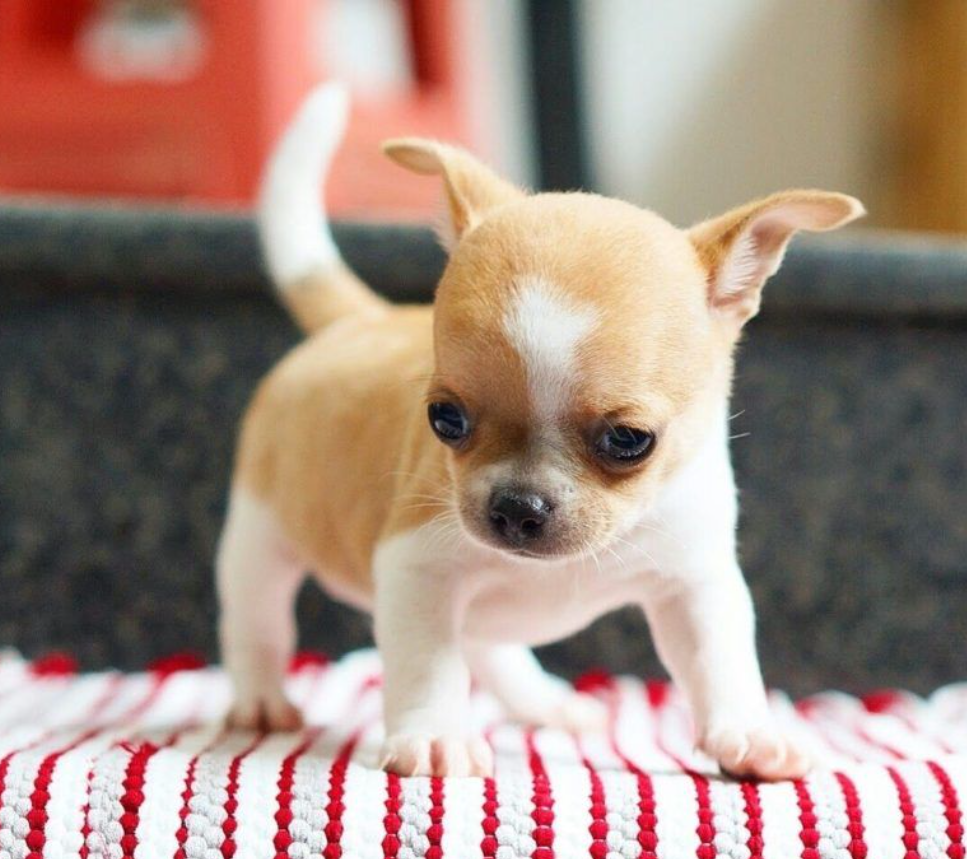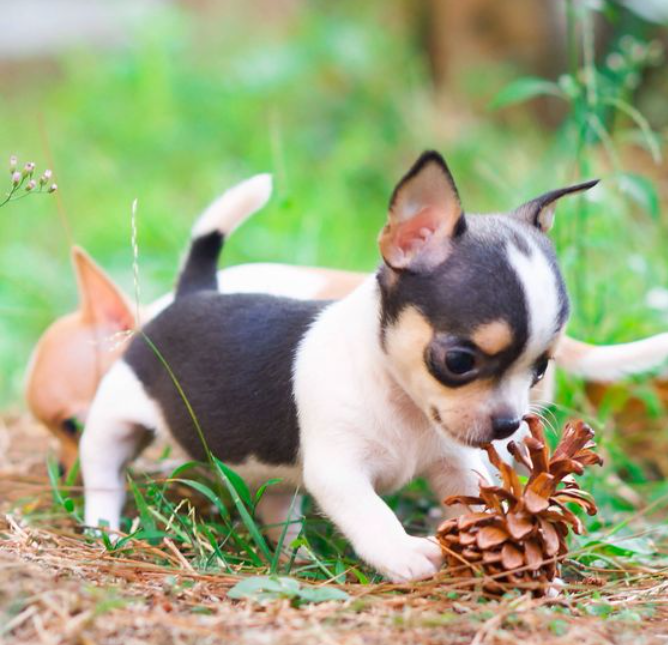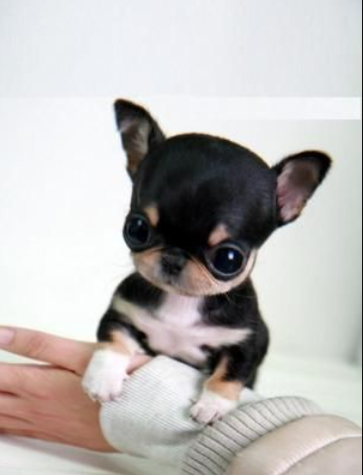A common nickname for chihuahuas is “deer head” or “apple head,” depending on how they look and behave.
Many believe the Chihuahua breeds deer head and apple head are recognized types. However, you won’t find them listed in the Chihuahua breed criteria based on their head shape.
Only long coat and smooth coat (short coat) variants are recognized by the American Kennel Club (AKC) and a few other Clubs. However, the apple-head chihuahuas do have specific characteristics that make them differ from other chihuahuas.
Let’s check out the details below for a more closer look into chihuahua’s life!
What is an Apple Head Chihuahua?
| Feature | Details |
|---|---|
| Origin | Mexico |
| Lifespan | 12-20 years |
| Size | 5-8 inches (12-20 cm) |
| Weight | 2-6 lbs (0.9-2.7 kg) |
| Coat Types | Short-haired & Long-haired |
| Temperament | Loyal, Alert, Energetic |
| Intelligence | High |
| Exercise Needs | Low to Moderate |
| Health Issues | Patellar luxation, Dental issues, Heart problems |
| Good for Apartments? | Yes |
One distinctive physical trait that can be counted on for the breed is the apple head appearance. The American Kennel Club requires the Chihuahua to have an ‘apple dome’ skull, regardless of whether it has a molera.

A portion of the dog’s skull that is sunken at birth is known as a molera. The ‘fontanelle,’ or soft area frequently appearing on a human baby’s head, is comparable to the molera in several ways.
Because of this depression, the Chihuahua’s head has been likened to the flat top of a ripening apple. In addition, because the dog’s skull’s dome is wider than its mouth, the top of the dog’s skull is also equivalent to a fruit.
According to the Chihuahua Club of America, the breed’s head has a noticeable “stop” that forms an approximately 90-degree angle when viewed in profile.
The ‘stop’ feature, a trait that is more prominent in some breeds, is the phrase used to refer to the slope that runs between the top of the forehead and the snout.
What Is the History of Apple Head Chihuahuas?
The smallest type of dog classified as a purebred per the American Kennel Club (AKC) is the chihuahua. The Chihuahua is regarded as Mexico’s national dog.
The Chihuahua breed is thought to have originated in the 1800s in the Mexican city of Chihuahua, hence its name in that language.
Ancient illustrations of a little dog akin to a chihuahua resembling the Techichi dog from ancient Asia and the Chinese Crested dog from ancient China have been found in Europe and Central America.
As a result, it is thought that the little, prehistoric Techichi dog may have been an early progenitor of the Chihuahua dog.
At some point along the bloodline, it may have been mixed with a Chinese Crested dog to produce the Chihuahua breed we know today.
What does apple head chihuahua look like?
If you compare apple-head chihuahuas with deer-head chihuahuas, apple-head chihuahuas have a smaller head. However, the teacup chihuahuas are even smaller than apple head chihuahuas, making the apple head chihuahua look bigger than them.
Apple head chihuahuas can have both short-haired fur coats and long-haired coats.

What are the notable characteristics of Chihuahuas?
The Apple Head Chihuahua is a cute little dog from puppyhood through adulthood. For a responsible dog owner, it will be a cute, teacup-sized lap dog, but because of its delicate nature, it could be easily damaged by excessive handling, especially by small children.
Since it typically has a mild demeanor and is not a breed that is known for being violent, it can be a charming and clever small pet if handled gently.
However, when irritated, it can become domineering and snap at strangers or kids. Being fragile, it might not be the best choice for a new owner or a young household who have larger dogs.
Furthermore, to understand their nature in more detail, here are a few characteristics of apple-head chihuahuas that are commonly noticed:
1. Affection and loyalty
Chihuahua owners will quickly learn that their small dog is eager to satisfy them and wants to be close by. They’ll be a fantastic friend, but their tiny size will restrict some of the things you can do together.
They will just enjoy spending time with you and will be devoted to their Chihuahua owner, although they must be kept safe and ideally in an enclosed space to prevent injuries.
2. Reputation among the dog community
Chihuahuas are known for having short fuse, being irritable, barking excessively, and being temperamental. This is somewhat accurate; if they are entitled to get bored, irritated, or teased, they can become noisy.
The Chihuahua is a cheerful, self-assured little dog, but it has a reputation for barking excessively at bigger dogs whenever people approach.

3. Chihuahua’s Popularity
Although the Chihuahua dog breed is not among the most popular in the world, it is slowly gaining acceptance as an adorable, affordable family pet.
It rose to fame in the 1990s as the Taco Bell mascot and is currently the 30th most popular dog in the country.
They can now compete as purebred dogs in the show ring in any coat and eye color combination, provided they have a nicely rounded ‘apple dome’ head, according to the AKC’s registration of the breed standard.
4. Training ability
These tiny dogs are intelligent, highly energetic, and strong-headed, making them a bit difficult to train. The dog likes to boss around and be active but won’t easily listen to the owner’s commands.
Despite its tiny physique, the demanding and determined dog prefers to stay active. It will desire to prove the trainer wrong and take over. It can be difficult to teach and can be stubborn, so patience and a lot of work are required.
They might strive to outdo the trainer and take charge of the training exercises, and they occasionally succeed in outdoing the dog owner. They need to understand who is in charge, and it shouldn’t be them—through tough but gentle instruction and punishment.
5. Intellectual ability
Because of its small size, fragility, and lightweights, this breed of dog more than makes up for its lack of strength with tenacity and attitude.
It will be active, and due to its high degree of intellectual ability, it will seek out helpful and satisfying activities to engage in. They will attempt to satisfy their dog owner, but if they are not entertained, they may seek out their own amusement, which may be harmful.
6. Socializing ability
To keep a Chihuahua puppy safe and well-behaved, early socialization and training are essential.
This breed needs to learn control to keep itself safe in crowded places if danger arises because of its delicate appearance and sensitivity to injury.
They can be welcoming, but not with everyone, and if someone approaches them quickly and sees them as a threat, they may growl at young kids or other dogs.
They must receive training in order to know how to act in crowded areas, parks, around strangers, and kids, or while close to traffic.
7. Adaptability
Chihuahuas prefer to be around groups of other pups of their size. Although they get along well with people of all ages and may easily fit into a family, it is not advised to leave them unattended with very small kids because they are at risk for injury.
Because of their intelligence, they will take pleasure in performing small, purposeful dog duties.
8. Temperament
They must be kept active with numerous short walks; otherwise, they will become bored, yap, or flee, so keep them within a secure area of your yard or house.
This tiny dog is stubborn and determined, and it will make every effort to push its boundaries. They will be anxious to please their owner and grateful for compliments on their good behavior.
They appreciate snuggling up next to their master or for warmth on their clothing or bedclothes.
Apple Head Chihuahua Vs. Deer Head Chihuahua: what’s the difference?
Apple-head chihuahuas are often compared with deer-head chihuahuas. Even though they look a little similar, there are a few slight differences among both types. Also, remember, they are not two different breeds, but two different types of one breed – Chihuahua.
Below, I have ruled out the difference between apple-head chihuahuas and deer-head chihuahuas based on parameters such as Head shape, physical appearances like size and height, health, and popularity.
1. Head Shape
The deer head is defined by a longer snout than the apple head and a shorter snout than the apple-head chihuahua, which is somewhat short.
The deer-headed chi also has a bit more of a slope on the head when viewed from the side, as opposed to a 90-degree angle. Many people like the “foxy” appearance that the deer head has because of this slope.
2. Height and Weight
General physical and visual differences are there, too. A deer head might have longer legs and a taller body than an apple head, which might have shorter legs. Deer heads often weigh more than those of other chihuahuas because of the difference in weight.
3. Health differences
Deer-headed chihuahuas are more likely to suffer dental and breathing problems. However, birthing a deer-headed chihuahuas is easier for the mother chihuahuas as their skull is narrower than apple head chihuahuas.
Therefore, birthing apple head chihuahuas is painful to the dog due to their broader structure.
4. Popularity in the dog owner community
A few years ago, deer head chihuahuas were declared not to fit the standard chihuahua criteria made by the Chihuahua Club of America as they are appealing enough as other chihuahua types. However, that doesn’t make them lacking as a chihuahua.
Moreover, many chihuahua lovers find deer-headed chihuahuas more than the other types. Regardless of their looks, they are amazing companions to be around.
Related Reads
Wrapping Up: Apple Head Chihua Is Good For First-time Dog Owners
Apple head chihuahuas are the cutest little creatures with a high level of energy and are one of the famous toy dogs. Despite having such a petite body, they are protective, bossy, and aggressive.
Also, despite their head shape, all chihuahuas have the same behavioral characteristics and live for about 14 to 20 years.
However, Apple head chihuahuas are indeed loyal companions when it comes to protecting their owners.
FAQs
Because they are little dogs, chihuahuas live longer than medium- and large-sized canines. A healthy Chihuahua should expect to live for 15 years on average, while some live to be 17 and sometimes 20.
Fully grown Apple Head Chihuahuas typically weigh around 6 lbs, with some reaching up to 8 lbs. They stand between 6 and 9 inches tall.
It costs $150 if you adopt it from an adoption agency or you get it from a breeder; it will cost you around $1000.
